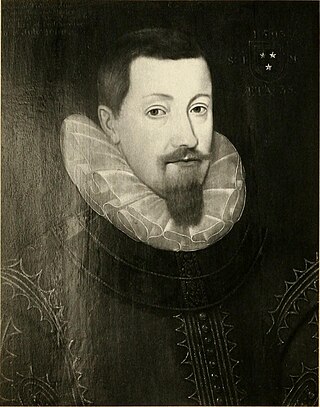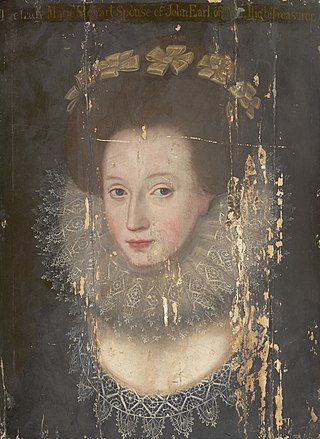Related Research Articles
Walter Stewart, 1st Lord Blantyre Educated with James VI under George Buchanan at Stirling Castle, he was a gentleman in the king's chamber, Knight of Cardonald, Prior of Blantyre, Keeper of the Privy Seal of Scotland from 1582 to 1596, an Extraordinary Lord of Session from 1593, an Octavian from 1596, and Treasurer of Scotland from 1596 to 1599
Sir Lewis Bellenden of Auchnole and Broughton was a Scottish lawyer, who succeeded his father as Lord Justice Clerk on 15 March 1577.
William Schaw was Master of Works to James VI of Scotland for building castles and palaces, and is claimed to have been an important figure in the development of Freemasonry in Scotland.
Sir William Stewart of Houston was a Scottish soldier, politician and diplomat.
The Octavians were a financial commission of eight in the government of Scotland first appointed by James VI on 9 January 1596.

Adrian Vanson was a portrait artist who worked for James VI of Scotland.
Jean Fleming, Countess of Cassilis (1553/4–1609) was a Scottish noblewoman and courtier at the court of James VI of Scotland, and a survivor of domestic violence.

John Murray, 1st Earl of Tullibardine was a Scottish courtier and leader of the Clan Murray.

Marie Stewart, Countess of Mar (1576-1644) was a Scottish courtier. She was the daughter of Esmé Stewart, 1st Duke of Lennox, a favourite of James VI of Scotland, and Catherine de Balsac. After her marriage, as was customary in Scotland, she did not change her name, and signed her letters as "Marie Stuart".
George Young was a Scottish churchman, courtier, member of the Privy Council of Scotland, diplomat, and secretary depute.

Henrietta Stewart (1573–1642) was a Scottish courtier. She was the influential favourite of the queen of Scotland, Anne of Denmark.
Margaret Stewart, Mistress of Ochiltree was a courtier in the household of Anne of Denmark in Scotland and looked after her children Prince Henry, Princess Elizabeth, and Charles I of England
Sir James Sandilands was a courtier to King James VI and I and captain of Blackness Castle
Sir William Keith of Delny was a Scottish courtier and Master of the Royal Wardrobe. He also served as ambassador for James VI to various countries. He was an important intermediary between George Keith, 5th Earl Marischal and the king, the king and courtiers, and the king and foreign governments.

John Gibb of Knock and Carribber (c.1550-1628) was a Scottish landowner and courtier.
William Stewart was a Scottish courtier.
Thomas Kerr of Ferniehirst was a Scottish landowner, Roman Catholic and supporter of Mary, Queen of Scots. He and Jean Scott ended the feud between the Scott family and the Kerrs. Thomas and Jean were both involved with supporting Mary, Queen of Scots.

Queen Elizabeth I of England paid a subsidy to King James VI of Scotland from 1586 to 1602. This enabled her to influence James by delaying or deferring payments to his diplomats in London. Records survive of the yearly amounts, and details of the expenditure in some years. A large proportion of the money was spent on the royal wardrobe of James and Anne of Denmark. Some royal expenses were met by Anne of Denmark's dowry, which was known as the "tocher". The regular incomes of the Scottish crown were feudal rents, customs, and "compositions" charged on grants of land. Accounts for royal incomes and payments survive as the exchequer rolls and lord treasurer's accounts and have been published as historical sources.
Adam Erskine, Commendator of Cambuskenneth, was a Scottish landowner and courtier.
John Cockburn of Ormiston was a Scottish lawyer and landowner.
References
- ↑ Gordon Donaldson, Register of the Privy Seal: 1581-1584, vol. 8 (Edinburgh, 1982), p. 316 no. 1880.
- ↑ HMC Report on the manuscripts of Colonel David Milne Home of Wedderburn Castle (London, 1902), pp. 70-71.
- ↑ George Powell McNeil, Exchequer Rolls of Scotland, vol. 22 (Edinburgh, 1903), pp. xlii, 297, 311, 348, 356, 365, 367, 386.
- ↑ National Records of Scotland, Register of the Privy Seal, PS1/67 f.125.
- ↑ Michael Pearce, 'Anna of Denmark: Fashioning a Danish Court in Scotland', The Court Historian, 24:2 (2019) pp. 140, 147
- ↑ Letters of John Colville (Edinburgh, 1858), pp. 128-30.
- ↑ Annie I. Cameron, Calendar State Papers Scotland: 1593-1595, vol. 11 (Edinburgh, 1936), p. 548: Marguerite Wood, Extracts from the Burgh Records of Edinburgh: 1589-1603, vol. 6 (Edinburgh, 1927), pp. 129-130.
- ↑ David Masson, Register of the Privy Council of Scotland: 1592-1599, vol. 5 (Edinburgh, 1882), pp. 462-3, 467-8.
- ↑ Amy Juhala, 'For the King Favours Them Very Strangely', in Miles Kerr-Peterson and Steven J. Reid, James VI and Noble Power (Routledge: Abingdon, 2017), pp. 162-3.
- ↑ Duncan Thomson, Painting in Scotland, 1570-1650 (Edinburgh, 1975), p. 57.